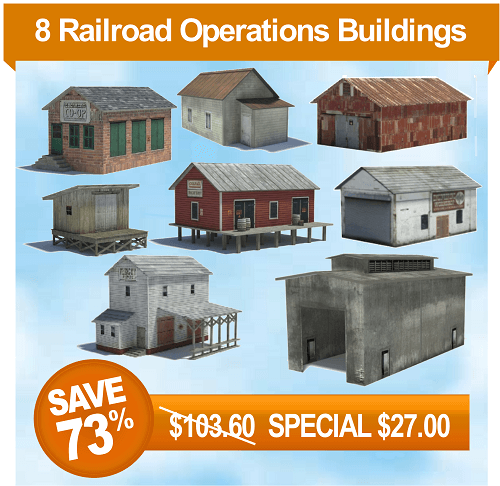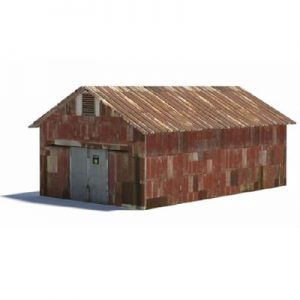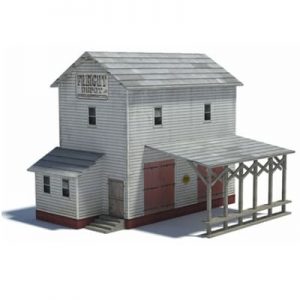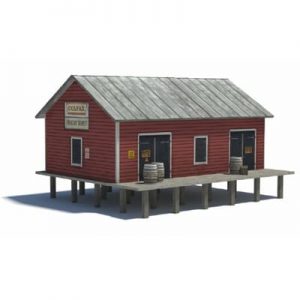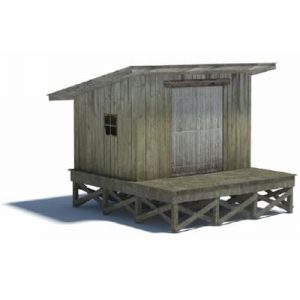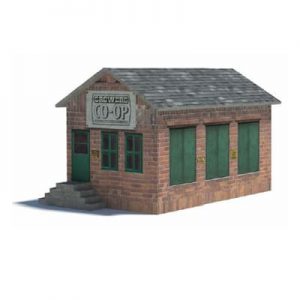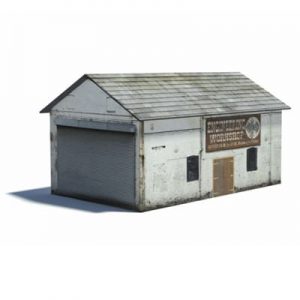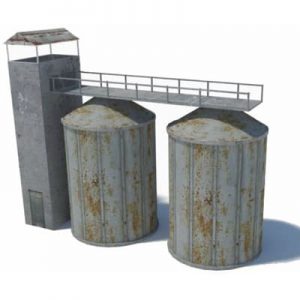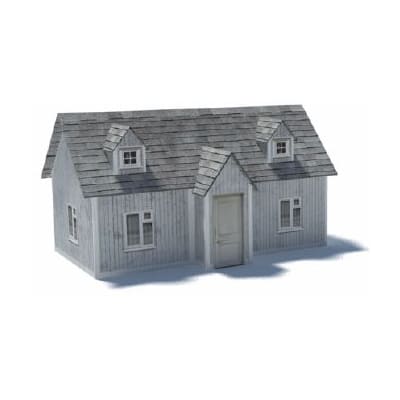Railroad Operations Pack Deal
All railways need structures beside the track to service the trains and railroad operations. Download and print.
Original price was: $103.60.$27.00Current price is: $27.00.
& Free ShippingOver 200 Plans for Constructing Model Buildings from Cardstock including an HO scale Engine House
Model building plans are available for construction of an HO scale engine house, OO gauge engine house, or N scale engine house.
B436 model railroad engine house building. This is a scale model that can be constructed as a HO scale engine house, or to OO scale, or N scale. By comparison the full life-size prototype building would be 58.5ft L x 28.5ft W x 31ft H (approx)
No denying, this model railroad loco house workshop is not pretty – it’s not supposed to be. It is the big concrete building where all the repairs and maintenance is done on steam and diesel locomotives. This HO scale engine house model building is realistically weathered and would look the part on a well-weathered scale railroad. See the discount buy above.
Almost all medium sized model railroads have probably one (or two) locomotive houses – many larger railroads will have several. That not surprising when you consider exactly how many locomotives most modelers have in their collection. An engine repair house (workshop) is not only an ideal building to store steam and diesel locomotives, but it also gives wonderful character to a rail yard.
This HO scale engine house / workshop / shed (whatever you like to call it), couldn’t be described as beautiful, far from it. Some might even call it ugly, but that’s precisely what gives it so much authenticity and character. It is no hard to imagine busy maintenance crews working on servicing and repairing the locomotives to keep them in good operating condition. These model buildings are designed to look authentic, not beautiful.
This scaled down HO scale engine house replicates a big concrete slab building with huge open ends for easy track access from both ends. The model structure looks dirty just like one might imagine a busy workshop would be. So, unless you actually want to, you needn’t bother doing any detailing or weathering to make it look genuine – it already looks the part!
To begin the construction, firstly download the B436 N scale or OO / HO scale engine house plan. It is a paper PDF (a very common and user-friendly format). Save the paper PDF file to your computer (or USB stick) so you know where to locate it when you want to print out copies of the model buildings. Choose the scale you are going to set your printer settings to. The current paper plan is available to download in OO scale (the size you download) which can be scaled to 87 percent for precise HO scale sizing, or the paper plan can be downloaded to N scale sizing. After printing out the PDF paper plan you glue the various parts onto some old cardstock (maybe the card backing of a muesli packet). Cut each part out when dry and adhere them together… and the model building is completed unless you decide to touch up the edges a little by using an artist brush. You could then spray the finished model buildings with matt varnish, however that is entirely optional.
The best buy is the multi package deal featured above. With that you get the big concrete HO scale engine house workshop, a small railroad shed, a small railway station, and an impressive silos facility among other model buildings in the range.
Every model railroad has scenery and structures and almost always has a railway station for passenger trains to pull up to so passengers can on and off. Train stations vary in size depending on their location and can be anything from a terminus (or terminal) station, to a through station (where local trains stop for passengers and express trains and freight trains pass through without stopping). A railroad station can take many forms and can service passengers only, freight only, or service both freight and passenger traffic.
The small yellow wooden train station in our series of scale model buildings is the kind of structure you might see on a small branch line; or on a mainline (without the trains stopping). It has a window where passengers can purchase a train ticket when the station is manned. It is a very different type of building when compared to the HO scale engine house mentioned above. This small rural railway station has much more character and charm, whereas the engine house id grubby and a massive size to accommodate locomotives undergoing maintenance.
To assemble this small rural railway station model, all you do is download the PDF paper model file, print the file out, glue it onto some old cardboard ( mentioned an old recycled muesli box as being suitable), and glue the train station plan together. It is really that easy!
This railroad station has charm but still looks like it has seen better days… and that’s why this and other model buildings on our website look so realistic. You won’t have to work on any additional weathering to the building… unless you choose to.
The PDF paper model kit comes with simplified drawings showing you the correct position for each part. You can’t go wrong.
Building a Model Train Layout – A Guide for Beginners To Model Trains and Construction of Scale Model Buildings and Scenery
Your passion for model trains can range from owning a beginners model train set to designing a large train layout yourself. If you are just a beginner, then starting with smaller layouts is usually the most feasible option. Not only will it give you an idea about the space that you need to build a scale railroad, but it will also help you assess your ability to design a more complex layout. Starting off at a smaller setup will give you a taste of designing and modeling train layouts and it will also help you recognize your strengths and weaknesses. Constructing scale model buildings using paper, card, corflute, or balsa wood is a good way to get started.
Make sure that you start with a simple project. It will save you the hassle of dealing with a lot of the details and complexities involved in a difficult railroad. You can keep on enhancing your skills by adding more details to your setup over time. Building a model train layout is not a race, so make sure that you take your time in completing the layout properly. Your aim should be to get it right and not just finishing it off without any attention to the details. Fortunately the model buildings you’ll see here already have the detailing done for you. Downloaded plans for some of the model buildings have textures that have cracks, mold, faking paint, and other imperfections you would expect to see on a naturally aged real life structure. No airbrushing or weathering is required on these model buildings.
Things to Consider When Building Your First Model Train Layout
Following are some things that you need to focus on before you start constructing a model railroad:
Available Space
The most important thing is the available space. Your working space will help you in selecting a scale for your railroad that fits your working space. Scenery, track, structures and model buildings can utilize a considerable amount of space, so careful planning is essential.
Size of the Scale
The next thing is the scale that you choose to use for your trains and for building your railway. There are several different sizes so you can choose a size that is suitable for your needs:
• O scale is one of the largest and is 1/48th of the original size.
• HO is 1/87th of the original and is half of the O scale.
• N scale is one of the smallest scales and its size ranges from 1/148th to 1/160th of the original.
You can choose from any of these scales depending on the space that you are working in. If you are a beginner, N may be the most feasible scale to start with, although in saying that, HO scale is the most popular as it is seen as being a medium size. Just remember that smaller scale trains and buildings require less space, but are more fiddly to handle. Model buildings can be downloaded in OO gauge / HO scale, or N scale, so if you want an HO scale engine house you can have one to the exact scale.
Deciding the Theme
The next thing to decide is the theme that you will use to construct your railroad layout. You can set the theme of your layout around a specific era. This will give you a direction for designing your train layout and help you planning the scenery around it.
Designing the Scenery
After choosing the theme, you will have to work on the scenery of the railroad. This is the part where you experiment and add things that you like to your layout like scale model buildings or an HO scale engine house.
Assembling the Railroad
The most important thing is to put it all together in a way that all the components of your design emerge as a cohesive model in the end. Be realistic while you design the scenery as this will give your railroad a natural and practical look.
These are just a few of the basic details that you need to know before you start building a model train layout. As you gain more experience and work with different types of trains and/or scales, you will find out that there is a lot that you can do with your railroad. Adding realistic details to your layout will not only breathe life into your railway, but it will also make it more interesting and challenging. Here are some ideas to get you started.
Making Forests
When you want to depict a forest in your railroad scenery, you need to start with the base of the forest. Use a dark dull paint to color the floor of the forest like a muddy brown or dull gray-green. Also scatter some debris like leaves or colored foam pieces to give a lifelike appearance.
To make the trees of the forests, you can easily break off some branches from the tree in your backyard. Collect some thin branches or twigs and cut them in different sizes to show tree variety. If the base of your bench work is hardwood, then you would have to drill holes to insert the trees. If it’s foam, you can stick the trees with glue. To add leaves to your trees, you can either use real leaves or you can use the store manufactured bushes. The color again depends on the type of forest you want. Simply glue the leaves on branches and your forest is ready!
To add some woodchips to your forest, you can purchase ground cover in various grades, textures, and colors from online model train stockists like Woodland Scenics. Alternatively, you could collect lots of pencil shavings and scatter them on the forest ground. Either method will make your model forest look more lifelike. Model buildings will also provide character and interest to the total scene you create.
Making Streams
Water features (streams, rivers, lakes, ponds etc) can look very realistic if you use epoxy resin and special water compounds to make them. However, if it’s a lazy stream you want, then it’s a stream you will get. You don’t have to go to extreme lengths to make the water look realistic. There is one very simple way. Just take tin-foil and crinkle it up. Straighten it out, cut it into the desired length and paste it where you want the stream to be. The tin-foil is shiny and when it is scrunched up, gives the appearance of flowing water. Just make sure you put lots of bushes, lichen and rocks around it to make it look real. These types of streams can be created among mountainous areas.
Enjoy your trains, and have fun with your model train scenery construction!


